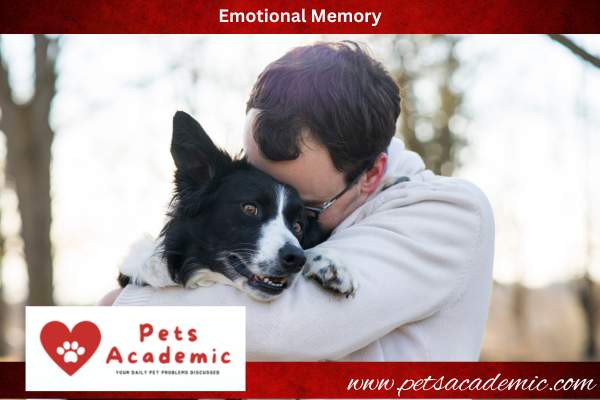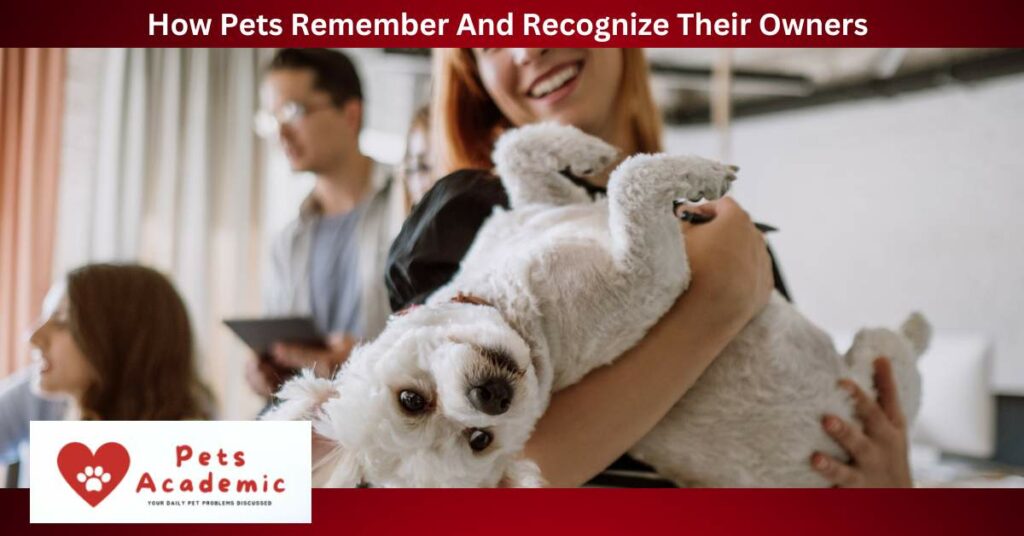Pet owners know that their furry friends are much more than just animals; they are family members.
Pets bring joy, comfort, and companionship to people’s lives.
Treating them like family means taking care of their physical and emotional needs, including understanding their memory and recognition abilities.
What Is Pet Memory And Recognition?

Pet memory is the ability of animals to store, retain, and retrieve information about past experiences, people, and places.
Recognition is the ability of pets to identify and remember familiar faces, objects, and scents.
Studies have shown that dogs, cats, and other animals have long-term memory storage capabilities and can remember events for weeks or even months.
The Importance Of Understanding Pet Memory

Understanding a pet’s memory and recognition abilities can help pet owners to:
- Improve pet training: Knowing how pets store and retrieve information can help owners develop effective training methods that align with their pet’s memory strengths.
- Identify cognitive decline: As pets age, their memory and recognition abilities can decline, leading to behavioral changes.
Knowing what to look for in these changes can help pet owners to detect cognitive decline early and seek specialized care.
- Increase pet bonding: Recognizing the importance of familiar people, places, and routines can help pet owners to strengthen the bond they share with their pets.
Moreover, pets’ memory and recognition abilities are often linked to their emotional well-being.
Understanding how animals store and retrieve information can help pet owners to provide the best possible care and enhance their pet’s overall quality of life.
Short-term Memory and Recognition
Pets can store short-term memories of events and experiences that have occurred within the past few minutes.
They usually rely on their sensory memory, which refers to the immediate and brief retention of sensory information, to hold onto these memories.
Through sensory memory, pets can remember a scent, sound, or visual image that they have encountered recently.
For instance, if a cat smells a piece of tuna, she can remember that scent for a few minutes.
As a result, if her owner opens a can of tuna later, the cat may recognize the scent and come running to the kitchen.
Similarly, dogs can remember a familiar toy or object they have played with in the past few minutes.
How Pets Recognize Familiar Faces, Objects, And Scents

Pets can recognize familiar people, objects, and scents through associative memory.
This type of memory involves linking a sensory input to a specific event or experience.
Through associative memory, pets can develop long-term memories of their owners’ faces, voices, and scents, as well as their homes’ feeling and familiar surroundings.
Additionally, pets may use their sense of smell and sensory cues to recognize familiar places or objects.
For example, they may associate a specific park with the scent of other dogs, grass, and trees.
Over time, they can recognize and remember these smells and associate them with the positive experience of playing with other dogs.
The Relevance Of Understanding Short-Term Memory And Recognition For Pet Owners
Understanding how pets process and store short-term memories and recognize familiar faces, objects, and scents can help pet owners provide better care and training to their furry friends.
They can develop effective training methods that align with their pets’ memory strengths, enhance their overall quality of life, and strengthen their bond with their pets.
Moreover, recognizing the importance of familiar people, places, and routines can help pet owners to increase their pets’ emotional well-being.
As pets age, their memory and recognition abilities may decline, leading to behavioral changes.
Knowing what to look for in these changes can help pet owners to detect cognitive decline early and seek specialized care.
Long-term Memory
Pets can process and form long-term memories through repeated exposure and reinforcement of experiences.
Long-term memory refers to storing information over a more extended period, lasting from days to a lifetime.
Pets can form long-term memories of their owners, other animals, objects, and experiences that they encounter over time.
The formation of long-term memories in pets requires an active process called consolidation.
During this process, the pets’ brain converts short-term memories into more permanent structures that can be retrieved later.
Therefore, pets that experience a particular event repeatedly will have a higher chance of consolidating those memories and storing them for a longer time.
This process is essential in helping pets learn new skills and adapt to their environment, even as they grow older.
How Pets Retrieve Long-Term Memories

Pets can retrieve long-term memories through recall, recognition, and relearning.
Recall involves retrieving a memory from the past in response to a specific cue or situation.
Recognition is identifying a familiar object or person through contextual clues.
Relearning is reacquiring a memory that had been lost due to lack of use or brain damage.
Pets can perform remarkable behaviors that demonstrate their long-term memory abilities.
For example, dogs can learn and remember hundreds of words, names of toys, and even people.
On the other hand, cats can remember the location of their litter box or the sound of their owners coming home from a long day at work.
Implications For Pet Owners
Understanding how pets form and retrieve long-term memories can help pet owners facilitate their pets’ learning and memory retention.
Consistent reinforcement of good behaviors and regular training sessions can improve pets’ long-term memory storage and improve their overall quality of life.
Similarly, pet owners can use positive reinforcement to reduce unwanted behaviors such as barking, biting, or scratching, by reinforcing good behaviors.
Additionally, recognizing the effects of aging on pet memory and learning abilities can help pet owners detect behavioral changes and seek appropriate medical attention early.
Enriching their pets’ environment with stimulating activities, toys, and social interactions can help improve their cognitive functions and prevent cognitive decline in old age.
Scent-Based Recognition
Pets have an extraordinary sense of smell and use it as a primary means of communication and identification.
Scent-based recognition is a crucial component of how pets form and recall long-term memories, particularly when it comes to remembering their owners.
Dogs, for example, have a remarkable sense of smell and can recognize their owners by their scent.
They can discern the unique smell of their owner’s skin, hair, and clothing, which they associate with the positive experiences they have had with them.
This association between scent and positive experiences reinforces the formation of long-term memories and creates strong emotional bonds.
Cats, conversely, use scent marking as a means of recognition.
They secrete pheromones from their facial glands, which they use to mark objects or individuals they consider safe and familiar.
They are also sensitive to the scent of their owners and associate it with positive experiences such as feeding or petting. This recognition helps cats to feel more secure and content in their environment.
Remembering and recognizing scents is crucial for pets’ overall mental and emotional well-being. It allows them to navigate their environment, find food, and identify potential threats or friends.
Moreover, scent-based recognition also helps pets to recall positive experiences, promoting their feelings of comfort and security.
Visual Recognition
Pets have a remarkable ability to recognize their owners visually. They can discern various visual cues, including body shape, walking style, and facial features.
Optical recognition plays an essential role in pets’ ability to form long-term memories and create emotional bonds with their owners.
Dogs, for example, are highly responsive to visual cues.
They can recognize their owner’s face, body shape, and even their gait.
Studies have shown that dogs use their visual memory centers to identify familiar faces, similar to humans.
They can also detect subtle visual cues, such as facial expressions and eye movements, which they associate with their owner’s emotions.
Cats also use visual recognition to identify their owners. They can recognize their owners’ faces, body shapes, and other visual cues such as clothing and accessories.
They are also sensitive to the tone of their owner’s voice, which they associate with positive experiences such as feeding and playing.
Recognizing their owners visually is crucial to pets’ emotional and mental well-being.
It helps them to form strong emotional bonds with their owners, which promotes feelings of security and comfort. Moreover, visual recognition helps pets to navigate their environment, identify potential threats, and find food.
Auditory Recognition
Pets not only rely on visual cues but also on auditory recognition to identify their owners.
Sound plays a vital role in pets’ ability to navigate their environment, communicate with others, and recognize their owners.
They can also recognize specific words and commands, which they associate with particular actions or rewards. The tone of the owner’s voice also plays a crucial role in how dogs interpret commands and their mood.
Similarly, cats can recognize their owners’ voices and may respond differently to different tones of voice.
They may also recognize specific sounds associated with feeding or playtime, which they learn through consistent training and reinforcement.
Other pets, such as birds and rodents, also use auditory cues to identify their owners.
They can recognize specific sounds, such as whistles or clicking sounds, which they associate with positive experiences such as food or attention.
Emotional Memory

Pets can remember emotional experiences with their owners.
They can recall positive and negative experiences, which can influence their behavior and reactions towards their owners in the future.
Dogs, for instance, can remember experiences linked to rewards or punishment, and they will remember the associated emotions and behaviors.
Dogs may also associate certain environments, smells, or sounds with specific experiences and emotions.
These emotional memories can last for a long time, and dogs may react differently in similar situations in the future.
Cats also have a good memory when it comes to emotional experiences with their owners.
They may remember positive interactions, such as petting or feeding, which can strengthen their bond with their owners.
Cats may also remember negative experiences, such as being scared or mistreated, which can cause them to become fearful or avoidant of their owners in the future.
Similarly, birds, rodents, and other pets may also remember emotional experiences with their owners.
They may associate certain actions or sounds with positive or negative experiences and will react accordingly.
As a pet owner, it is crucial to understand how pets process and remember emotions.
Positive reinforcement, consistent training, and a nurturing environment can help pets develop positive emotional memories and strengthen their bond with their owners.
Conclusion
It is crucial for pet owners to understand how pets process and remember emotions.
Positive reinforcement, consistent training, and a nurturing environment can help pets develop positive emotional memories and strengthen their bond with their owners.
On the other hand, negative experiences can cause pets to become fearful or avoidant of their owners.
In conclusion, the memories and recognition of pets go beyond simple associations and can have a significant impact on their behavior and reactions towards their owners.
It is important for pet owners to provide a positive, nurturing environment for their pets to help them develop positive emotional memories and strengthen their bond.
More Articles: The amazing world of twin pets and their unique bonds.
The fascinating world of animal hierarchies: Who’s really in charge?

